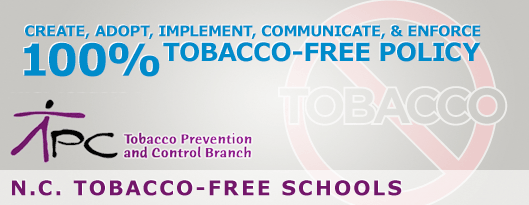Note: This site documents N.C.’s work on making public schools tobacco free, from 2000 until state law went into effect in 2008, and is provided as a resource for states and communities currently working to make their schools tobacco free. Factual information reflects research and data from 2000-2008.
Checklist for Communicating a 100% Tobacco-Free School Policy
Tobacco policy implementation can be challenging, and without effective communication, the policy will be unenforceable. To help in this effort, we have provided a range of communication ideas and
strategies to ensure that all members of the school and community – students, staff and visitors – are aware of the policy, understand the rationale behind it, and are clear on the consequences if the
policy is violated. No matter what stage your district is in – just getting started, implementation, or dealing with enforcement issues – experience shows that communication must be clear, ongoing, and
consistent. We encourage you to work with members of your school and community to identify the best strategies for your school district.
Checklist for communicating with students:
- Post prominently placed tobacco-free school signs at all entrances to school buildings, school grounds, parking lots, athletic facilities, and in school and activity buses.
- Place details in student handbooks and orientation guides.
- Review and discuss policy at student orientation meetings including meetings with new and transfer students.
- Spread the information through student organizations, activities and newspapers.
- Make announcements over morning broadcasts at school and over loudspeaker systems at school events.
- Have students design posters, banners, and signs to communicate the new policy.
- Tell students about opportunities for tobacco cessation support programs in the community and provide information about how students can access these programs.
- Involve student groups or clubs to assist in communicating the policy – such as Teens Against Tobacco Use (T.A.T.U.).
- Encourage, support and empower students to appropriately confront other students and visitors who are violating the policy.
- Include information in student newspaper articles and email blasts and on school websites and social media pages.
- Inform students of youth-centered tobacco and vaping cessation programs. Find them here: https://tobaccopreventionandcontrol.dph.ncdhhs.gov/youth/Documents/TobaccoPreventionCessationProgramResources-for-YoungPeople.pdf
Checklist for communicating with employees:
- Post prominently placed tobacco-free school signs at all entrances to school buildings, school grounds, parking lots, athletic facilities, and on vehicles.
- Provide every school district employee with a copy of the policy and a letter of explanation from the school board.
- Discuss the policy at staff meetings and new staff orientation.
- Hold in-service training on tobacco-related school policies for all staff, including teaching staff, bus drivers, aids, food service workers and maintenance staff.
- Post information, along with a copy of the policy, in staff lounges or offices.
- Include information in staff newsletters and emails.
- Tell staff about 1-800-Quit-Now and other tobacco cessation support programs in the community.
- Inform potential employees of the policy in all job interviews. Include a statement that the school district is tobacco-free on all job applications.
- Involve respected and well-liked school personnel in sharing messages with staff groups.
Checklist for communicating with parents/guardians:
- Provide information at parent open houses at the start of the new school year.
- Post prominently placed tobacco-free school signs at all entrances to school buildings, school grounds, parking lots, and athletic facilities.
- Send a letter to each parent or guardian that: 1) explains the policy change; 2) provides the health, academic and social reasons for the change; 3) outlines the consequences for violators; and 4) asks
for support in enforcement.
- Discuss the policy changes at PTA, PTO, or similar meetings.
- Include an article outlining the policy and implications of the policy in parent-oriented newsletters and school or community newspapers.
- Announce the new policy at all athletic events, meetings, concerts and plays. Have students develop and/or deliver announcements.
- Include information in parent email blasts and post on school website and social media pages.
Checklist for communicating with the public/community:
- Place an ad in the paper thanking the school board for their decision to make the school district 100% tobacco-free.
- Ask other community agencies such as Healthy Carolinians, tobacco control coalitions, PTAs, PTOs and asthma coalitions to include an article about the new tobacco-free school policy in their newsletters, on their websites and social media pages.
- Post prominently placed tobacco-free school signs at all entrances to school buildings, school grounds, parking lots, and athletic facilities. Other places to post signs include gathering places, restrooms,
loading areas, and stairwells.
- Remove all ashtrays from school property.
- Announce the new policy at all athletic events, meetings, concerts and plays. Include announcements in event bulletins.
- Train students, staff and community volunteers to politely ask community members to respect school policy. Avoid communicating in a way that sounds judgmental or that would create or escalate conflict.
- Ask students, staff, and community volunteers to assist in distributing informational flyers regarding the policy at school events.
- Communicate the policy to parent and business volunteers who assist in supervising youth during off-campus activities, including field trips, job shadowing or community service.
- Inform vendors who provide supplies, materials and services on a regular basis to the school about the policy. Use an official memo, face-to-face communications or include a clause in the written contract
agreement.
- Include information on school website and social media pages.
(Adapted from School Tobacco Policies, Oregon Department of Human Services, 2002)


